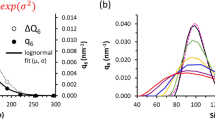Summary
The greater hip fracture rate among elderly women is generally ascribed to differences in femoral neck strength between the sexes. Strength of a given bone is a function of both its material properties and the magnitudes of mechanical stresses within it. This study examined the hypothesis that these apparent strength differences between the sexes are due to dissimilarities in the restructuring of the femoral neck with age, which result in higher stresses in elderly women. Using Hip Strength Analysis, a computer program developed by the authors, femoral neck cross-sectional geometric properties for stress analyses were derived from bone mineral image data of 409 community living, white subjects ranging from 19 to 93 years of age. Though both sexes show declines in femoral neck bone mineral density (BMD) and cross-sectional area with age, only females show a decline in the cross-sectional moment of inertia (CSMI, a geometric index of bone rigidity). The lack of decline in male CSMI appears to be a result of a small but significant increase in femoral neck girth. Similar age-related changes have been observed in the femoral shaft by others. The net effect of these observed changes is that mechanical stresses in the femoral neck of females appear to increase at three times the rate per decade of those of males. These results lend support to the hypothesis that the higher fracture rate in elderly women is due, at least in part, to elevated levels of mechanical stress, resulting from a combination of greater bone loss and less compensatory geometric restructuring with age.
Similar content being viewed by others
References
Gallagher JC, Melton LJ, Riggs BL, Bergstrath E (1980) Epidemiology of fractures of the proximal femur in Rochester Minesota. Clin Orthop Rel Res 150:163
Riggs BL, Wahner HW, Seeman KP, Offord KP, Dunn WL, Mazess RB, Johnson KA, Melton LJ III (1982) Changes in bone mineral density of the proximal femur and spine with aging. J Clin Invest 70:716–723
Bohr H, Schaadt O (1983) Bone mineral content of femoral bone and the lumbar spine measured in women with fracture of the femoral neck by dual photon absorptiometry. Clin Orthop Rel Res 179:240–245
Libanati CR, Schulz EE, Baylink DJ (1987) Bone loss in the proximal femur: a major determinant for hip fractures. Transactions of the 33rd Annual Meeting of the Orthopaedic Research Society 12:379
Vose GP, Lockwood RM (1965) Femoral neck fracturing: its relationship to radiographic bone density. J Gerontology 20:300–305
Burstein AH, Reilly DT, Martens M (1976) Aging of bone tissue: mechanical properties. J Bone Joint Surg 58A:82–86
Yamada H (1970) Strength of biologic materials. Evans FG (ed) Williams and Wilkins, Baltimore
Pauwels F (1976) Biomechanics of the normal and diseased hip. Translated by RJ Furlong and P Maquet, Springer-Verlag, 1976
Smith RW, Walker RR (1964) Femoral expansion in aging women: implications for osteoporosis and fractures. Science 145:156–157
Martin RB, Atkinson PJ (1977) Age and sex-related changes in the structure and strength of the human femoral shaft. J Biomechanics 10:223–231
Yeater RA, Martin RB (1984) Senile osteoporosis. Postgrad Med 75:147–163
Ruff CB, Hayes WC (1982) Subperiosteal expansion and cortical remodeling of the human femur and tibia with aging. Science 217:945–948
Ruff CB, Hayes WC (1988) Sex differences in age-related remodeling of the femur and tibia. J Orthop Res 6:886–896
Gies AA, Carter DR, Sartoris DJ, Sommer FG (1985) Femoral neck strength predicted from dual energy projected radiography. Proc. 31st Annual Meeting of the Orthopaedic Research Society 10:357
Phillips JR, Williams JF, Melick RA (1975) Prediction of the strength of the neck of the femur from it's radiological appearance. Biomed Engr 10:367–372
Beck TJ, Ruff CB, Warden KE, Scott WW Jr, Rao GU (1990) Predicting femoral neck strength from bone mineral data: a structural approach. Invest Radiol 25:6–18
Shock NW, Gruelich RC, Andres RA, Arenberg D, Costa PT, Lakatta EG, Tobin (eds) (1984): Normal human aging. The Baltimore Longitudinal Study of Aging, US Govt. Printing Office, Washington, DC
Beck TJ, Scott WW Jr, Ruff CB (1991) Studies in the structural analysis of hip bone mineral data: the effect of femoral anteversion. Proceedings 3rd Int Symp on Osteoporosis, Copenhagen Denmark, 1990
Mazess RB, Barden HS, Drinka PJ, Bauwens SF, Orwoll ES, Bell NH (1990) Influence of age and body weight on spine and femur bone mineral density in US white men. J Bone Miner Res 5:645–652
Author information
Authors and Affiliations
Rights and permissions
About this article
Cite this article
Beck, T.J., Ruff, C.B., Scott, W.W. et al. Sex differences in geometry of the femoral neck with aging: A structural analysis of bone mineral data. Calcif Tissue Int 50, 24–29 (1992). https://doi.org/10.1007/BF00297293
Received:
Revised:
Issue Date:
DOI: https://doi.org/10.1007/BF00297293




